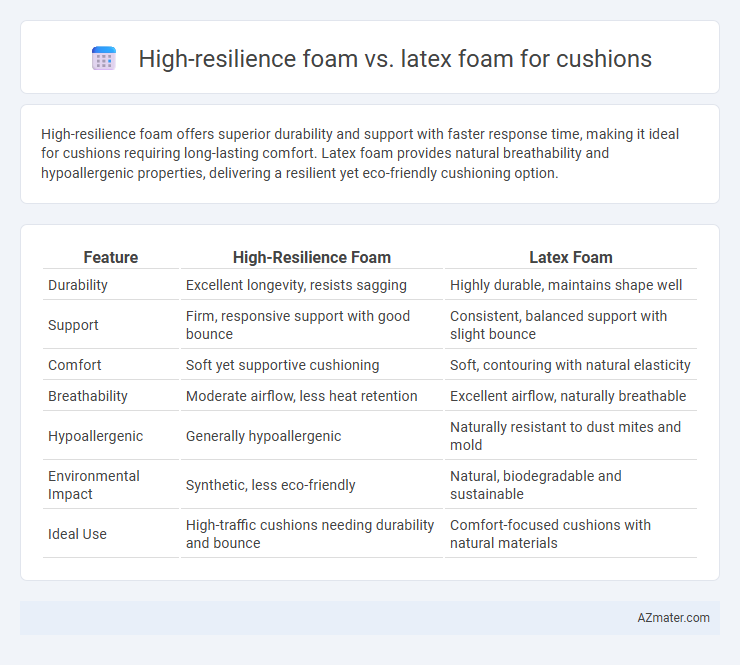High-resilience foam offers superior durability and support with faster response time, making it ideal for cushions requiring long-lasting comfort. Latex foam provides natural breathability and hypoallergenic properties, delivering a resilient yet eco-friendly cushioning option.
Table of Comparison
| Feature | High-Resilience Foam | Latex Foam |
|---|---|---|
| Durability | Excellent longevity, resists sagging | Highly durable, maintains shape well |
| Support | Firm, responsive support with good bounce | Consistent, balanced support with slight bounce |
| Comfort | Soft yet supportive cushioning | Soft, contouring with natural elasticity |
| Breathability | Moderate airflow, less heat retention | Excellent airflow, naturally breathable |
| Hypoallergenic | Generally hypoallergenic | Naturally resistant to dust mites and mold |
| Environmental Impact | Synthetic, less eco-friendly | Natural, biodegradable and sustainable |
| Ideal Use | High-traffic cushions needing durability and bounce | Comfort-focused cushions with natural materials |
Introduction to Cushion Materials
High-resilience foam offers superior support and durability, making it ideal for cushions that require both comfort and long-lasting performance. Latex foam, derived from natural or synthetic rubber, provides excellent elasticity and breathability, promoting a cooler seating experience. Comparing density, resilience, and airflow highlights key differences essential for selecting the most suitable cushion material.
What is High-Resilience Foam?
High-resilience foam is a durable polyurethane foam known for its excellent support and quick recovery after compression, making it ideal for cushions requiring long-lasting comfort and shape retention. This foam's open-cell structure enhances breathability and responsiveness, providing a balance between firmness and softness. Compared to latex foam, high-resilience foam typically offers greater resilience and affordability, though it may have less natural elasticity and hypoallergenic properties.
Overview of Latex Foam
Latex foam, derived from natural or synthetic rubber, offers exceptional elasticity and durability, making it a preferred choice for cushion materials. Its open-cell structure provides superior breathability and resistance to dust mites and mold, enhancing comfort and hygiene. The foam's ability to evenly distribute body weight reduces pressure points, contributing to long-lasting support and comfort compared to high-resilience foam.
Support and Comfort: High-Resilience vs Latex
High-resilience foam offers superior support with its durable, responsive cell structure that maintains shape under prolonged pressure, making it ideal for users seeking consistent firmness and shock absorption. Latex foam delivers exceptional comfort through its natural elasticity and contouring ability, providing pressure relief and enhanced breathability, which promotes cooler and more comfortable seating. Both materials excel in durability, but latex foam's hypoallergenic properties and eco-friendliness appeal to those prioritizing natural, breathable cushioning solutions.
Durability and Longevity Comparison
High-resilience foam offers superior durability due to its high-density structure, maintaining shape and support over extended use, ideal for cushions subjected to frequent pressure. Latex foam, made from natural or synthetic rubber, provides excellent longevity with intrinsic resistance to wear, mold, and dust mites, ensuring a longer lifespan in diverse environments. When comparing both, high-resilience foam excels in bounce-back and firmness retention, while latex foam outperforms in natural resilience and hypoallergenic properties, making it a durable, long-lasting choice for cushion applications.
Breathability and Temperature Regulation
High-resilience foam offers moderate breathability due to its open-cell structure, allowing some airflow to regulate temperature during use. Latex foam excels in breathability and temperature regulation because its naturally porous composition permits superior air circulation, reducing heat retention and moisture buildup. Consumers seeking enhanced cooling and moisture-wicking properties often prefer latex foam cushions for long-lasting comfort.
Allergen Resistance and Health Factors
High-resilience foam offers moderate allergen resistance with its dense structure that limits dust mite accumulation but may retain more heat compared to latex foam. Latex foam is naturally hypoallergenic, resistant to dust mites, mold, and bacteria, making it a healthier choice for allergy sufferers and individuals with respiratory issues. Both materials provide supportive cushioning, but latex foam's antimicrobial properties enhance overall sleep hygiene and reduce potential allergen exposure.
Cost Differences and Affordability
High-resilience foam offers a budget-friendly option with moderate durability, making it more affordable for large-scale cushion production compared to latex foam, which typically commands a higher price due to its natural materials and superior longevity. Latex foam provides exceptional support and longevity but comes with increased upfront costs, often ranging from 20% to 50% more than high-resilience foam cushions. Consumers seeking cost efficiency often prefer high-resilience foam for its balance of performance and affordability without the premium price tag of latex alternatives.
Environmental Impact and Sustainability
High-resilience foam, typically made from petroleum-based polyurethane, has a larger carbon footprint and slower biodegradability compared to natural latex foam, which is derived from rubber tree sap and is biodegradable and renewable. Latex foam production supports sustainable rubber tree farming practices with carbon sequestration benefits, reducing overall environmental impact. Choosing latex foam cushions promotes sustainability through natural materials and reduced chemical use, while high-resilience foam often involves petrochemical dependency and challenges in eco-friendly disposal.
Choosing the Right Foam for Your Cushion
High-resilience foam offers superior support and durability due to its open-cell structure, making it ideal for cushions that require long-lasting comfort and shape retention. Latex foam provides excellent elasticity and natural resistance to mold and dust mites, making it a hypoallergenic choice suitable for sensitive users. When choosing the right foam for your cushion, consider factors like firmness preference, usage frequency, and allergies to maximize comfort and longevity.

Infographic: High-resilience foam vs Latex foam for Cushion
 azmater.com
azmater.com